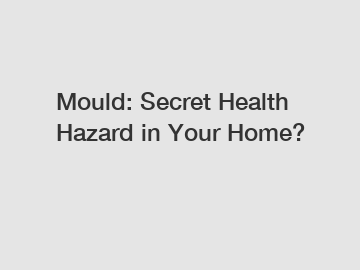Apr. 05, 2024
Mould: Secret Health Hazard in Your Home?
When thinking about potential health hazards in our homes, most people tend to overlook one silent but serious threat: mould. Mould, also known as mildew, is a type of fungus that thrives in damp and dark environments. While it may seem harmless at first glance, mould can actually pose a significant risk to our health if left unchecked.
Mould can grow on a variety of surfaces, including walls, ceilings, floors, and even furniture. It thrives in moist environments, making bathrooms, kitchens, and basements common breeding grounds for mould growth. While some types of mould are relatively harmless, others can produce harmful substances known as mycotoxins that can cause a range of health problems.

One of the most common health issues associated with mould exposure is respiratory problems. Breathing in mould spores can irritate the lungs and airways, leading to symptoms such as coughing, wheezing, and shortness of breath. In severe cases, mould exposure can even trigger asthma attacks in individuals with existing respiratory conditions.
In addition to respiratory problems, mould exposure has also been linked to other health issues, such as skin rashes, allergic reactions, and even more serious conditions like fungal infections. This makes it crucial to address any mould growth in your home as soon as it is detected to prevent these health risks from becoming a reality.
So, how can you protect yourself and your family from the dangers of mould? Here are a few tips to help you keep mould at bay:
1. Keep your home dry and well-ventilated: Mould thrives in damp environments, so it's important to keep your home dry and well-ventilated to prevent mould growth. Make sure to fix any leaks or water damage promptly, and use dehumidifiers or fans to reduce moisture levels in areas prone to mould growth.
2. Clean and disinfect regularly: Regular cleaning and disinfecting can help prevent mould growth by removing the spores before they have a chance to take hold. Pay special attention to areas like bathrooms and kitchens, where moisture levels are typically higher.
3. Check for signs of mould: Keep an eye out for any signs of mould growth in your home, such as musty odours, discoloured walls or ceilings, or visible patches of mould. If you spot any of these signs, take action immediately to address the issue before it spreads.
4. Use mould-resistant products: Consider using mould-resistant paint and sealants in areas prone to mould growth, such as bathrooms or basements. These products can help prevent mould from taking hold and make it easier to clean up any mould that does appear.
By following these tips and taking proactive steps to prevent mould growth in your home, you can protect yourself and your family from the potential health hazards associated with mould exposure. Don't let this silent threat lurk in the shadows – take action to keep your home safe and healthy for years to come.
For more information, please visit china tool maker, china custom injection molding, automotive molds.
Previous: What are the advantages of injection moulding?
Next: How to Achieve Precision and Efficiency with 3 Shot Injection Molding
If you are interested in sending in a Guest Blogger Submission,welcome to write for us!
All Comments ( 0 )